Other Manuscripts
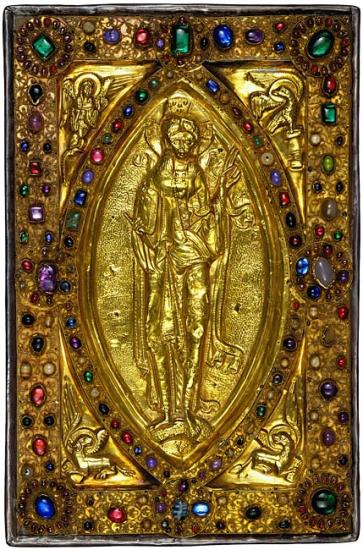
Christ In Majesty With The Four Living Creatures
Flanders, third quarter of the eleventh century, for Judith, countess of Flanders. On a Gospel Book, in Latin.
The popular theme of Christ in Majesty surrounded by the four symbols of the evangelists (eagle, man, lion, ox) is based on John's vision of the throne of heaven with the four living creatures (Rev. 4). His vision, in turn, was inspired by that of Ezechiel, where cherubim supported the throne chariot of God.
The Apocalypse, or Book of Revelation, is not only the last Book of the New Testament, but its most difficult, puzzling, and terrifying. It provided challenges to medieval illustrators and was the source for a number of popular images, such as Christ in Majesty, the Adoration of the Lamb, and the Madonna of the Apocalypse and contributed to the widespread use of the Evangelists' symbols.
Selected images from Apocalypse Then: Medieval Illuminations from the Morgan, an exhibition held at the Morgan are presented here. The exhibition celebrates the completion of a facsimile of the Morgan's Las Huelgas Apocalypse—the latest dated (1220) and largest surviving manuscript of a Spanish tradition of illuminated commentaries on the Apocalypse by the monk Beatus of Liébana. The series of manuscripts constitutes Spain's most important contribution to medieval manuscript illumination.
The Las Huelgas Apocalypse contains three sections: the prefatory cycle, the Apocalypse, and the Book of Daniel.
In addition to forty-nine images from the Las Huelgas Apocalypse, six images from other manuscripts in the Morgan's collections, including the earliest Beatus painted by Maius and one by the Master of the Berry Apocalypse, are in this presentation.
MS M.644 (fols. 86v–87)
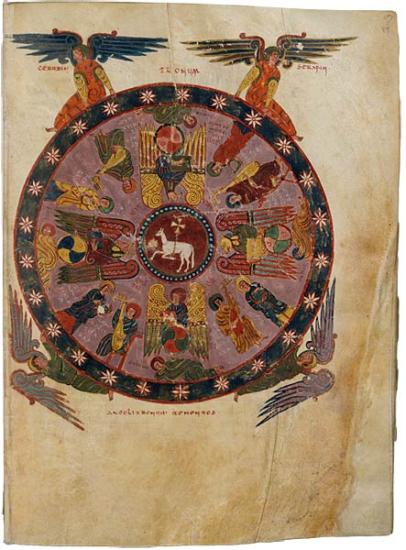
The Vision of the Lamb
This page is from one of the earliest surviving illuminated manuscripts in the Spanish tradition. Written and illuminated by Maius (ca. 945) in the famous tower scriptorium of the monastery of San Salvador de Tabara, it is the most important Spanish illuminated manuscript in the United States.
At the center of the composition is a cross-bearing Lamb, the symbol of Christ. The Lamb is surrounded at the four cardinal points by the living creatures, holding books. A century later these creatures were interpreted as the symbols of the four evangelists (the eagle is John; the lion, Mark; the man, Matthew; and the ox, Luke). Between the creatures are adoring ancients with four-stringed gitterns and vials. Four angels hold the outer border of twenty-four stars. The miniature is one of the finest by Maius, who both wrote and painted this book, a masterpiece of Mozarabic illumination and the earliest complete Spanish Apocalypse.
The Apocalypse, or Book of Revelation, is not only the last Book of the New Testament, but its most difficult, puzzling, and terrifying. It provided challenges to medieval illustrators and was the source for a number of popular images, such as Christ in Majesty, the Adoration of the Lamb, and the Madonna of the Apocalypse and contributed to the widespread use of the Evangelists' symbols.
Selected images from Apocalypse Then: Medieval Illuminations from the Morgan, an exhibition held at the Morgan are presented here. The exhibition celebrates the completion of a facsimile of the Morgan's Las Huelgas Apocalypse—the latest dated (1220) and largest surviving manuscript of a Spanish tradition of illuminated commentaries on the Apocalypse by the monk Beatus of Liébana. The series of manuscripts constitutes Spain's most important contribution to medieval manuscript illumination.
The Las Huelgas Apocalypse contains three sections: the prefatory cycle, the Apocalypse, and the Book of Daniel.
In addition to forty-nine images from the Las Huelgas Apocalypse, six images from other manuscripts in the Morgan's collections, including the earliest Beatus painted by Maius and one by the Master of the Berry Apocalypse, are in this presentation.
MS M.1079, fols. 6v–7
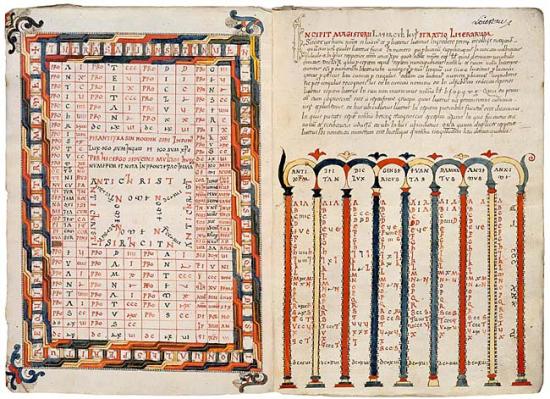
Two Antichrist Tables
Miscellaneous documents, letters, and treatises in Spanish, Latin, and Greek relating to Aragon, as well as seven watercolors after the Fanlo Beatus.
These watercolors, commissioned by Vincenio de Lastanosa of Huesca in 1635, are copies of a now lost Beatus then in the monastery of Montearagón. The original manuscript was a gift of King Ramiro I of Aragon (1035–1064) to Abbot Banzo of the monastery of San Andrés de Fanlo. It probably originated at the monastery of San Millán de la Cogolla in La Rioja, for it copies the Escorial Beatus that was made there.
Although the Apocalypse text does not include Antichrist tables, Beatus supplied them to simplify calculating the number of the Beast from the names for the Antichrist. In the first table the names are written vertically in black: Antichrist is first (followed by three other names in columns 5, 8, and 11). Each letter is given a numeric value in red in the next column. There are three more names in the bottom part. The second table is clearer. Antichrist, along with his seven other names, is inscribed below the arches (Teitan, Diclux, Gensericus, Evantas, Damnatus, Antemus, and Anxime). The alphabet beneath each name gives the numeric value of each letter. Added up, the numbers of each column yield 666 (DCLXVI at the bottom).
The Apocalypse, or Book of Revelation, is not only the last Book of the New Testament, but its most difficult, puzzling, and terrifying. It provided challenges to medieval illustrators and was the source for a number of popular images, such as Christ in Majesty, the Adoration of the Lamb, and the Madonna of the Apocalypse and contributed to the widespread use of the Evangelists' symbols.
Selected images from Apocalypse Then: Medieval Illuminations from the Morgan, an exhibition held at the Morgan are presented here. The exhibition celebrates the completion of a facsimile of the Morgan's Las Huelgas Apocalypse—the latest dated (1220) and largest surviving manuscript of a Spanish tradition of illuminated commentaries on the Apocalypse by the monk Beatus of Liébana. The series of manuscripts constitutes Spain's most important contribution to medieval manuscript illumination.
The Las Huelgas Apocalypse contains three sections: the prefatory cycle, the Apocalypse, and the Book of Daniel.
In addition to forty-nine images from the Las Huelgas Apocalypse, six images from other manuscripts in the Morgan's collections, including the earliest Beatus painted by Maius and one by the Master of the Berry Apocalypse, are in this presentation.
MS M.644 (fols. 219v–20)
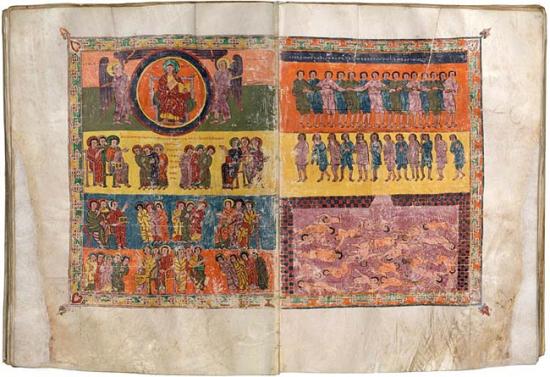
Last Judgment (Rev.: 20:11–15)
These pages are from one of the earliest surviving illuminated manuscripts in the Spanish tradition. Written and illuminated by Maius (ca. 945) in the famous tower scriptorium of the monastery of San Salvador de Tabara, it is the most important Spanish illuminated manuscript in the United States.
Christ the Judge sits at the top in a mandorla supported by two angels. Below, in three registers, are six pairs of seated saints (probably apostles), each pair with a saint standing behind. These bless the elect, represented by groups of nimbed saints. The registers at right contain the damned. The men at the top clasping hands are those damned together; below, men suffer individually; at bottom, the damned are tortured in a lake of fire with ovenlike walls. Maius tells us that he made this book so that the "wise may fear the coming of the future judgment of the world's end." The use of bands of color and miniatures extending over two pages represent Maius's contribution to the Beatus tradition.
The Apocalypse, or Book of Revelation, is not only the last Book of the New Testament, but its most difficult, puzzling, and terrifying. It provided challenges to medieval illustrators and was the source for a number of popular images, such as Christ in Majesty, the Adoration of the Lamb, and the Madonna of the Apocalypse and contributed to the widespread use of the Evangelists' symbols.
Selected images from Apocalypse Then: Medieval Illuminations from the Morgan, an exhibition held at the Morgan are presented here. The exhibition celebrates the completion of a facsimile of the Morgan's Las Huelgas Apocalypse—the latest dated (1220) and largest surviving manuscript of a Spanish tradition of illuminated commentaries on the Apocalypse by the monk Beatus of Liébana. The series of manuscripts constitutes Spain's most important contribution to medieval manuscript illumination.
The Las Huelgas Apocalypse contains three sections: the prefatory cycle, the Apocalypse, and the Book of Daniel.
In addition to forty-nine images from the Las Huelgas Apocalypse, six images from other manuscripts in the Morgan's collections, including the earliest Beatus painted by Maius and one by the Master of the Berry Apocalypse, are in this presentation.
MS M.240, fols. 3v–4
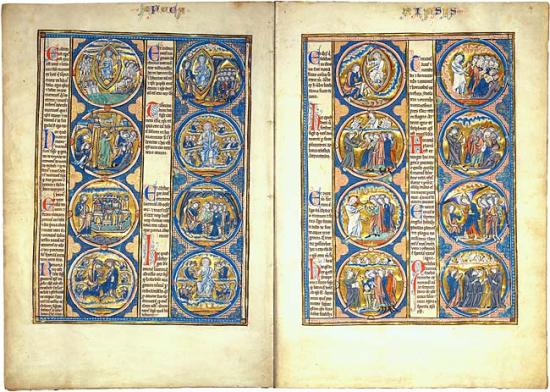
Moralized Bible, in Latin
The present fragment was originally the final portion of a three-volume Moralized Bible now in Toledo Cathedral, Spain. Each page contains two columns of roundels, totaling some 5,000 illuminations. The roundels alternately depict the biblical excerpts and the commentaries. Altogether there are 156 images illustrating biblical excerpts and another 156 the commentaries, making this the richest Apocalypse cycle ever conceived.
The Apocalypse, or Book of Revelation, is not only the last Book of the New Testament, but its most difficult, puzzling, and terrifying. It provided challenges to medieval illustrators and was the source for a number of popular images, such as Christ in Majesty, the Adoration of the Lamb, and the Madonna of the Apocalypse and contributed to the widespread use of the Evangelists' symbols.
Selected images from Apocalypse Then: Medieval Illuminations from the Morgan, an exhibition held at the Morgan are presented here. The exhibition celebrates the completion of a facsimile of the Morgan's Las Huelgas Apocalypse—the latest dated (1220) and largest surviving manuscript of a Spanish tradition of illuminated commentaries on the Apocalypse by the monk Beatus of Liébana. The series of manuscripts constitutes Spain's most important contribution to medieval manuscript illumination.
The Las Huelgas Apocalypse contains three sections: the prefatory cycle, the Apocalypse, and the Book of Daniel.
In addition to forty-nine images from the Las Huelgas Apocalypse, six images from other manuscripts in the Morgan's collections, including the earliest Beatus painted by Maius and one by the Master of the Berry Apocalypse, are in this presentation.
MS M.133v (fol. 57v)
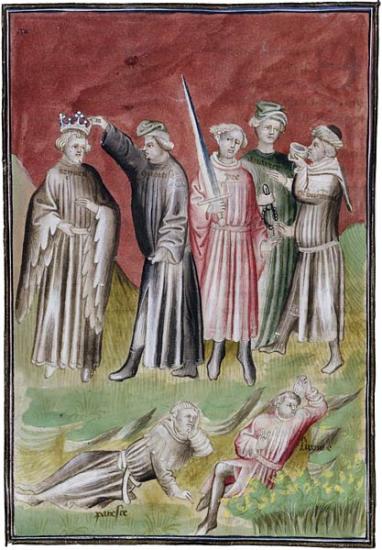
Seven Deadly Sins as the Seven Plagues
Apocalypse, with the commentary of Berengaudus, in French by the Master of the Berry Apocalypse
The seven plagues, following the commentary by Berengaudus (fl. 840–92), are interpreted as the Seven Deadly Sins, which some believed would take over the world as the end neared. Envy places a crown on Pride, Anger holds a sword, Avarice has a purse, and Gluttony drinks. Sloth is recumbent and Lust combs his hair. The manuscript was in the library of Jean, duc de Berry, the great French bibliophile who commissioned the Très Riches Heures. The anonymous artist responsible for its 85 miniatures was named the Master of the Berry Apocalypse after this book.
The Apocalypse, or Book of Revelation, is not only the last Book of the New Testament, but its most difficult, puzzling, and terrifying. It provided challenges to medieval illustrators and was the source for a number of popular images, such as Christ in Majesty, the Adoration of the Lamb, and the Madonna of the Apocalypse and contributed to the widespread use of the Evangelists' symbols.
Selected images from Apocalypse Then: Medieval Illuminations from the Morgan, an exhibition held at the Morgan are presented here. The exhibition celebrates the completion of a facsimile of the Morgan's Las Huelgas Apocalypse—the latest dated (1220) and largest surviving manuscript of a Spanish tradition of illuminated commentaries on the Apocalypse by the monk Beatus of Liébana. The series of manuscripts constitutes Spain's most important contribution to medieval manuscript illumination.
The Las Huelgas Apocalypse contains three sections: the prefatory cycle, the Apocalypse, and the Book of Daniel.
In addition to forty-nine images from the Las Huelgas Apocalypse, six images from other manuscripts in the Morgan's collections, including the earliest Beatus painted by Maius and one by the Master of the Berry Apocalypse, are in this presentation.